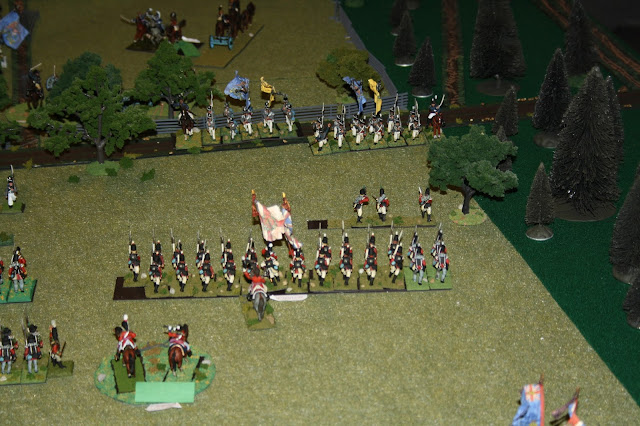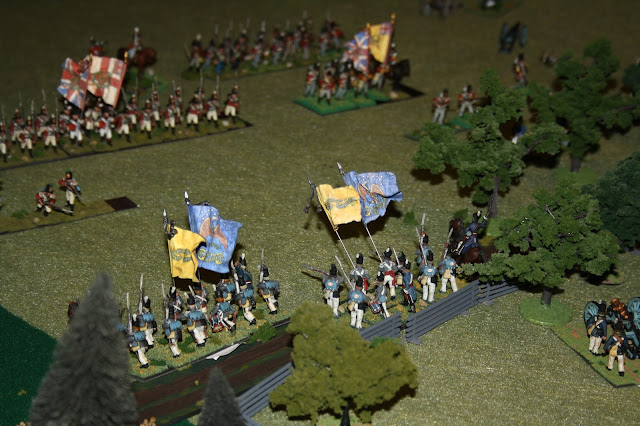Session Two consisted of the ten minute turns from 0520 to 0540. Unfortunately we did not start until about 1945 and finished at about 2145 hence only three turns. Nonetheless, they were momentous turns with significant impact on the American tactical plan.
Also, the 0530 turn D6 throw for the Grand River Indians resulted in a D1 = disperse., which gave the American forces some comfort. Note that the visibility increased to 24" at dawn 0530. This increase had a significant impact on the U.S. Second Brigade's advance in the face of British guns on LL hill top.
The following photos represent the situation at the end of 0540 turn:
A view of the American left flank. Note the gap in the middle of Scott's brigade. That is where the U.S. 25th stood. It was routed and subsequently dispersed by the Provincial Light Dragoons supported the 19th LD. Previously, the 19th LDs charged the US LD and won the melee, which resulted in a PUSH BACK for the US LDs
On the right the US 22nd are engaged with the 1st Foot (Royal Scots). The 1st concentrated their fire on Towson's 6pdr (left of the 22nd), eventually wiping out the crew.
Another view of left portion of the First Brigade. Both sides cavalry have withdrawn to their respective lines.
Another view of the right flank of the First brigade. Note the remnants of Towson's 6 pdr.
NTF. some debate ensued re "opportunity fire" from American artillery versus pursuing British cavalry. GdeB only provides for "Support Fire" by artillery during the charge phase when the enemy cavalry is at the half-way point. Nonetheless, I have posed the issue to the GdeB forum in hope of receiving some clarification. The following is what I posted:
Greetings
Gents,
In our
last week’s session of the Battle of Lundy’s Lane we came across an unique
situation regarding the possible use of “Opportunity Fire” from artillery.
The term
“Opportunity Fire” comes from a derivative of “Battles for Empire “that we use
for very large battles. Basically, it is meant to cover situations where an
enemy unit (usually cavalry) wonders across the frontage/arc of a friendly
artillery battery or an infantry battalion, in a movement or charge turn
(sometimes in pursuit of a friendly unit). So, while not in the firing phase
the friendly artillery unit could declare “opportunity fire” within certain
distance parameters.
The closest
GdeB rule that I have read that might address this situation, somewhat is 7.8 (3)
SUPPORT FIRE. At the half way point artillery could fire on the enemy charger
but not from long range.
However,
in our Lundy’s Lane situation the enemy cavalry was pursuing friendly cavalry (subsequent
to a charge—ie pursuit) and at one point came within the firing arc of a friendly
artillery unit. The artillery player declared opportunity fire and I reluctantly
ruled no as there did not seem to a GdeB rule to cover this type of situation.
Also, I
was aware of 10.29B - FRIENDLY UNITS ARE TOO CLOSE TO THE ENEMY RULE, which
states that friendly artillery can’t fire on enemy units that are within 6” of
a friendly unit.
Did I
make the right ruling?
Should
there be an “Opportunity Fire” rule option as part of GdeB rules.
Your
comments are gratefully appreciated.
A view of Ripley's Second Brigade facing off against the British artillery with the 89th Foot in support. The American plan to close with British guns in darkness has failed and with the increased visibility the American infantry is taking heavy casualties from canister fire. Ritchie's battery has taken some casualties from the behemoth 24 pdr and those infernal rockets!
Ripley has recovered from his light wound and has returned to the Second brigade to re-evaluate his tactical plan.
A view of the right flank of Second Brigade with Porter's 5th Pennsylvania bottom center. Incredibly, Norton's Mohawks are still in the building despite being at 50% manning (morale checks every turn) and being fired upon by engineers. Bottom right; the Canadian militia are engaged skirmish style with the Canadian (American) Volunteers in the woods.
A view from the British/Canadian left flank looking north up LL road. Center foreground left are the IMUC and beyond up the slope are the GLI. To the right is the 1st Canadian Militia Brigade (actually a battalion).
Another view of the British right flank looking south up LL. Mid left top--top to bottom....an unknown British unit, the remnant of the PLDs and the 19th LDs to the left and US LDs, Towson's howitzer and the 9th Infantry.
A close up of the command troop of the 19th Light Dragoons.
A close up of those infernal rockets.
A close up of the behemoth 24 pdr firing canister at the American Second brigade.
As stated despite a mere five turns, significant and possibly game changing events have occurred. Will Scott's brigade now have withdraw in the face of significant losses. What will Ripley's brigade now do in the face of withering fire from the hill top British guns?
Stay tuned for Session Three.

























































